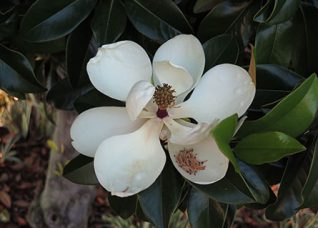
MinerAlert

MinerAlert
Magnolia mexicana [Syn. Talauma mexicana]
Magnoliaceae
Heartflower tree, Mexican heart flower, Chipahuac, Hualhua, Súchil, Yollochochitl, Yolosóchil, Yoloxóchitl, Yucacaca (Berdonces, 2007; White, 2002; Sánchez-Monge, 2001; Schoenhals, 1988).
Flor de corazón, Hierba de las mataduras, Laurel tulipán, Magnolia mexicana, Palo de peña (Berdonces, 2009; Adame and Adame, 2000; Quattrocchi, 2000; 2012; Mendoza-Castelán and Lugo-Pérez, 2011; White, 2002; Sánchez-Monge, 2001; Torkelson, 1996; Martínez, 1994; Schoenhals, 1988).

This tall tree is native to Mexico, Guatemala, and Honduras (Quattrocchi, 2000, 2012; Mabberley, 2008; Johnson, 1999; Morton, 1981), and has been used in Mesoamerican traditional medicine for many centuries (Argueta, 1994; Martínez, 1989).
Mainly the flowers are used, although the leaves and the tree bark are also occasionally employed (Argueta and Zolla, 2014; Berdonces, 2009).
Various parts of the tree, especially the seeds, bark, leaves and flowers, are decocted in water to make a tea.
The main use in Mexican traditional medicine is to treat heart ailments. Decoctions made from Mexican magnolia bark possesses similar effects as those of a very different plant known as digitalis or “foxglove” (Digitalis purpurea), which has also been used for centuries to treat cardiac problems, especially congestive heart failure. Other therapeutic applications of Mexican magnolia include atheromas, epilepsy, gout, fever, cardiovascular circulation, as a diuretic, to treat menstrual problems, and as an astringent (Johnson, 1999; Argueta, 1994; Morton, 1981).
The active compounds in this species have not been adequately studied. According to studies undertaken many years ago, the seeds contain a bitter compound (“talaumina”), oxalic acid, and iron. The bark also contains “talaumina”, as well as quercetin, and is used to treat fevers. A decoction of the flowers is taken to treat abdominal problems, heart ailments, and sterility. The flower petals possess an astringent action and are taken as a tea to treat gout. The flowers are also antispasmodic, and the seed decoctions are taken for paralysis. Wine prepared with the flower anthers is taken to treat epilepsy and convulsions in children (“alferesía”). The leaves contain an alkaloid known as “aztequina” (Berdonces, 2009; Argueta, 1994; Martínez, 1989; González de Cosío, 1984).
Mexican magnolia is sometimes combined with a related species, M. grandiflora, in order to treat anxiety and heart problems (Mendoza-Castelán and Lugo-Pérez, 2011; Argueta, 1994; Martínez, 1989). Drinking teas made from this plant can impart a disagreeable odor to the urine (Martínez, 1989).
A similar species related to Mexican magnolia, M. grandiflora, is an evergreen tree with fragrant and showy flowers native to the southeastern United States, and commonly known as “bull bay”. This tree is now cultivated throughout the world and its active constituents are employed for the treatment of skin diseases by the cosmetics industry. The essential oil obtained from the leaves has antioxidant activity and may have an effect on certain tumor cell lines in vitro (Morshedloo et al., 2017).
The essential oil obtained from the leaves also possesses important antifungal action against five strains of dermatophytic fungi. Additionally, the oil demonstrated antimicrobial activity against two bacterial species, Staphylococcus aureus and Streptococcus pyogenes that cause skin infections that could potentially lead to serious blood infections or sepsis (Guerra-Boone et al., 2013).
A study by Ibarra-Alvarado et al. (2010) showed that the aqueous extracts of various plants used by Mexican traditional medicine for the treatment of cardiovascular diseases are able to modify the tone of arterial smooth muscle. In this study, the aqueous extract of M. grandiflora induced concentration-dependent contraction of rat aortic rings. For this reason, the authors of the study suggested that this tree might possess potential beneficent health effects for the treatment of circulatory ailments, such as venous insufficiency, for example.
In the state of Hidalgo, Mexico, aside from M. grandiflora, teas made from the flowers of related species, including M. dealbata and M. schiedana (locally known as “chivillo” or “little goat”), for example are taken for the treatment of nervousness, high blood pressure, and heart ailments (Villavicencio-Nieto and Pérez-Escandón, 2006).
Safety/Precautions:
Before you decide to take any medicinal herb or herbal supplement, be sure to consult with your health care professional first. Avoid self-diagnosis and self-medication: Always be on the safe side!